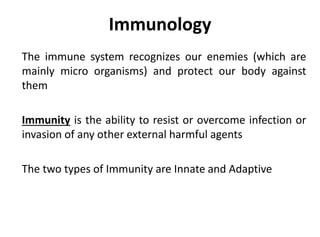
Immunology.ppt
- 1. Immunology The immune system recognizes our enemies (which are mainly micro organisms) and protect our body against them Immunity is the ability to resist or overcome infection or invasion of any other external harmful agents The two types of Immunity are Innate and Adaptive
- 3. Innate immunity is the first line of defense. It is inborn. It prevents the entry of harmful agents by putting up barriers (eg. Skin) or destroy them with specialized cells (eg. Macrophages). The pathogens have some molecules (not present in our normal cells) called Pathogen Associated Molecular Patterns (PAMPs) and the macrophages have receptors termed Pattern recognition receptors (PRS) to recognize them. Innate immunity is Nonspecific and without memory.
- 4. Adaptive immunity is the second line of defense. It is acquired when the immune system confronts pathogens / antigens (Active) or by directly getting the secreted mediators of immunity esp. antibodies (Passive). In practical terms: - Active immunity means antibodies are produced in our body against antigenic challenge ( Infection / Vaccination ) - Passive immunity means receiving readymade antibodies (From mother to child during fetal life and breast feeding / therapeutic administration) The cardinal features of adaptive immune responses are specificity, memory and self discrimination
- 6. Immunity Innate Adaptive Active Passive Cells having the Innate and adaptive functions can interact each other. Mostly, when a pathogen or antigen is encountered by the mediators of innate immunity, they release certain cytokines which induce inflammation and this in turn leads to the recruitment of the mediators of adaptive immunity.
- 9. • Important Cellular Components • Natural Killer Cells Innate • Antigen Presenting or Antigen Processing cells Innate and adaptive • Macrophages • T Cells • B Cells Only adaptive • Important Secreted Mediators • Antibodies Adaptive • Compliments • Cytokines Innate and adaptive
- 10. • Macrophages engulf (eat) the pathogen and digest them • Natural killer cells destroy the pathogen by releasing toxic substances • Antigen presenting / Antigen processing cells capture the pathogen / Antigen and process them. The processed antigens (antigenic determinants) are then presented to the T cells and / or B cells.
- 11. • B cells are Bone marrow derived lymphocytes and • T cells are thymus derived lymphocytes. • They are exclusively responsible for recognizing and destroying antigens / pathogens • B cell destroy the antigens by producing antibodies. This is termed humoral immunity or antibody mediated immunity (AMI) and is most effective in removing extra cellular antigens.
- 12. • There are basically two types of T cells – Helper T cells (Th0) which are CD4 cells and Cytotoxic T cells (Tc) which are CD8 cells • Tc directly destroy the antigens (infected cells) by releasing cytotoxins. This is termed as Cell Mediated Immunity (CMI) and is very essential for removing Intra Cellular Antigens. • On interaction with intra cellular antigen Th0 differentiate in to Th1 helper cells which in turn help the Tc leading to CMI. • On interaction with extra cellular antigens Th0 differentiate in to Th2 helper cells which in turn help the B cells leading to AMI